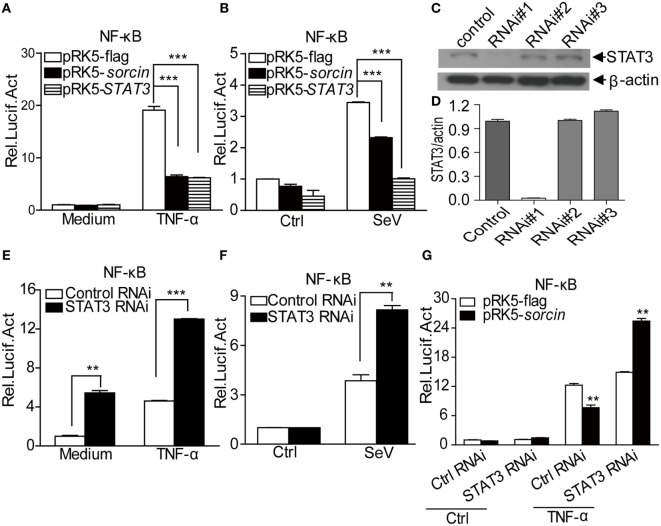Figure 7.
Roles of sorcin and signal transducer and activator of transcription 3 (STAT3) in TNF-α- or SeV-induced activation of NF-κB promoters. (A,B) Overexpression of sorcin or STAT3 inhibits TNF-α- or SeV-induced activation of NF-κB promoters. HEK293T cells were transfected with pRK5-sorcin or pRK5-STAT3 or empty vector together with indicated reporter plasmids. Eighteen hours after transfection, cells were treated with TNF-α or SeV. After treatment, the activities of NF-κB promoter were determined by luciferase assays. (C,D) Effects of STAT3 RNAi on the expression of endogenous STAT3. HEK293T cells were transfected with siRNA (#1–3) or controls as described in Section “Materials and Methods.” Twenty-four hours after the second transfection, cell lysates were prepared and examined by Western Blot with anti-STAT3 antibody (C). Endogenous β-actin expressions were used as internal controls. The density of bands in (C) was quantitated by densitometry (D). The relative levels of STAT3 in STAT3 RNAi cells were calculated as follows: the ratio (the band density of STAT3/that of actin in the same sample) of STAT3 RNAi/the ratio (the band density of STAT3/that of actin) of RNAi control. (E,F) TNF-α- or SeV-induced activation of NF-κB promoters were enhanced in STAT3 knockdown cells. HEK293T cells were transfected with the STAT3 RNAi construct or RNAi control together with indicated reporter plasmids. Eighteen hours after transfection, cells were treated as in (A,B). (G) Knockdown of STAT3 abolished sorcin suppressed activation of NF-κB promoters upon TNF-α treatment. HEK293T cells were transfected with STAT3 RNAi construct or RNAi control together with pRK5-flag-sorcin or empty vector and indicated reporter plasmids. Eighteen hours after transfection, cells were treated as in (A,B). (A,B,D,E–G) Results are representative of three independent experiments with similar results. Error bars are presented as mean ± SD, n = 3 cultures. The significance of difference between the groups was performed by two-way ANOVA (** stands for p < 0.01, and *** for p < 0.001).

